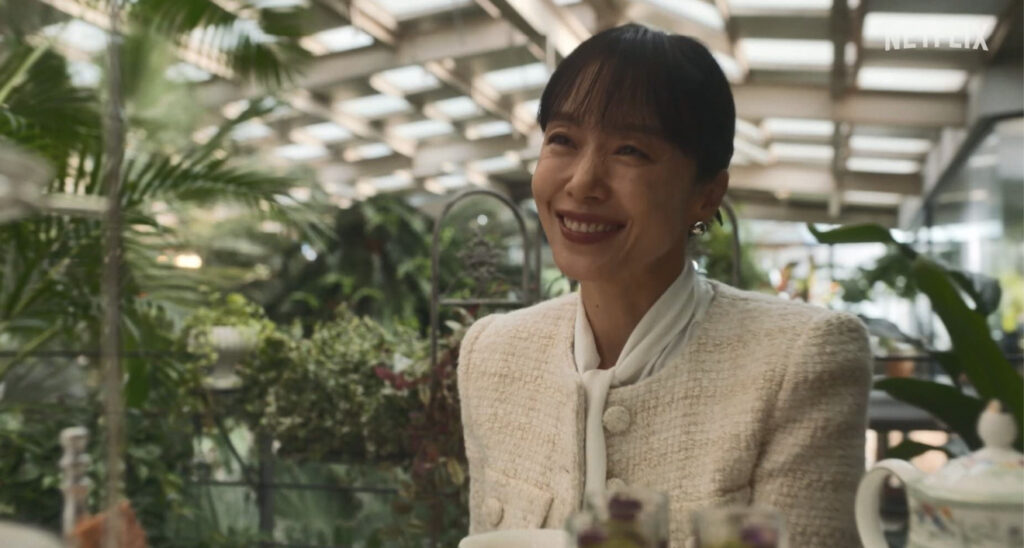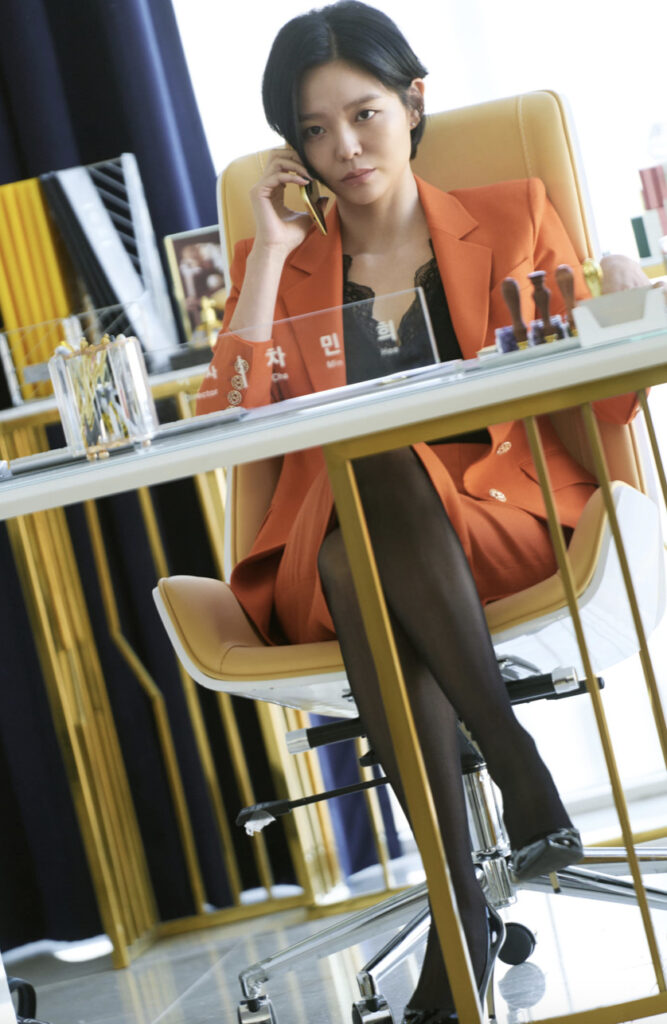
Synopsis : At work, she’s a renowned assassin. At home, she’s a single mom to a teenage girl. Killing is easy. It’s parenting that’s the hard part.
- Rating: TVMA (Language|Smoking|Violence)
- Genre: Action, Mystery & thriller
- Original Language: Korean
- Director: Byeon Seonghyeon
- Writer: Byeon Seonghyeon
- Release Date (Streaming):
- Runtime:
- Distributor: Netflix

Interview with Director Sung-hyun Byun
Q: You were creating the movie with Jeon Do-yeon in mind as a mother. There’s a lot of themes of fairness and weakness — her weakness in being a mother — or did you think that it was a weakness or a strength? Also, she’s the director’s weakness at the end but, it seems that she was everybody else’s weakness as well, including the intern who chose to stay loyal to her. What about Boksoon made her everybody’s weakness?
SB: Regarding the notion of weaknesses, Boksoon’s weakness as a mother is the fact that she kills people. And her weakness as a killer is that she has a daughter. That was pretty simple. The way you illustrated how Boksoon herself became a weakness for the other characters, that was very obvious. You know, we all want to hide our weaknesses. Min-kyu also wanted to hide the fact that Boksoon was a weakness for him.
Boksoon and Min-kyu tug at each other’s weaknesses, and Boksoon does it pretty openly. I think that Min-kyu also does it, in a way, to Boksoon. But while it seems like Min-kyu is coming to Boksoon with her weakness, I wanted to portray him as also a savior to Boksoon. He is described as a character who can give all and take all away. Boksoon is a character who says she doesn’t pray to a god. But towards the end of the story, you will find her looking or searching for a godly being.
And while she does so, the camera pans on the dead body of Min-kyu. I tried to bring in that sort of savior metaphor for him. There’s also a scene where in the death of one of the killer company representatives, the table is shaped in the form of a cross in order to metaphorically bring in that idea of the Savior as well. As for the intern, I wanted every character in “Kill Boksoon” to love and admire Boksoon, because that’s how I feel about the person and the actor Jeon Do-yeon in real life. I think that’s how all of the elements came about naturally, because it started from that admiration.
Q: You began the script for this movie based on thinking of Jeon Do-yeon specifically. You’ve had such an impressive list of movie projects — Kingmaker and you have a very impressive list more recently. How do you come up with the concepts for these particular films? Do you have a long list of ideas or does it just come to you all of a sudden?
SB: Many directors have a long list of ideas for their upcoming works. I am embarrassed to admit that I’m not the planning type. So after I’m done with a piece of work, I will wait a while and then think, “Okay, what’s next? What do I do now?” Sometimes I feel like if I try too hard to think about it, it doesn’t come to me. My ideas tend to come to me when I am not intentionally searching for them. This was the first time for me where the story all started from an actor. I feel like it’s also going to be my last time. I think going forward for my future work, I’m going to be focusing more on what kind of stories I want to tell.
This time, because of the process, it was challenging in a way because there was no set story that I wanted to tell, but because it was driven from, “Okay, I want to work with Jeon Do-yeon, what do we do?” I had written the opening sequence, but after finishing it, I had to wait for months to continue writing because I just didn’t have the story I wanted to tell. Over many conversations and meetings and grabbing drinks with Do-yeon, I got to see the discrepancy and irony of her being a mother and the top actor in Korea. So I was really intrigued by that and it all started from there.

Q: When it came to adapting the script into the film, what decisions did you make in regards to the amount of violence to the action?
SB: Except for the scene when Min-kyu becomes violent with the character Sergeant Shin on the table, I wanted to make the rest of the film very much like a comic book. I excluded that particular scene because it was the climax of the conflict and an important scene in order to show the character Min-kyu’s violence which he holds within. It also shows the level of affection that he has for Boksoon. That was an intentional decision. I very much wanted to bring in a comic book feel to the film, which is one of the reasons behind the opening sequence, when you see the character Boksoon being beheaded. If you think of her status within the Korean cinema industry, I felt it was a very bold, and quite an intriguing way to grab the audience. You see this extremely famous top actor, the main lead, and within minutes of the film’s opening, you see her beheaded. I brought it in as a sort of witty moment but I did realize that some people thought it was over-the-top violent.
Q: Jeon Do-yeon did get injured while she was shooting the film, but she got back to work pretty quickly. How cautiously did you prepare the set after she was injured?
SB: When you’re shooting an action film, issues related to safety are just so unpredictable. All you can do is be as cautious as possible. But Do-yeon was actually very eager, and she expressed her intention of wanting to do everything as was originally written. Despite that, I decided to go ahead and adjust a few parts of the action scenes that I felt were maybe a little too dangerous. But the next day after her injury, Do-yeon and I both said, “We are never doing an action film again.” Half-jokingly, our camera director also would say, “Yeah, this is not something to do.”
Even just watching what was going on on set, it was quite a painful process. For “Kill Boksoon,” we didn’t have a lot of stunt doubles, so most of the action-packed scenes had to be done by the characters themselves, because of the certain ways the scenes were made. So no matter how much preparation and training we went through, there were inevitable shortcomings. Rather than put in any extra caution, or additional mechanisms or anything like that, we just made some changes in terms of the methodology of the shooting. So for some of the longer takes, we decided to divide them into shorter ones and whatnot.

Q: “Kill Boksoon” is not just about revenge. You haven’t taken that clichéd approach about the hired contract killers that they are killing, but it has a sense of emotion in it. Was that a conscious decision before you wrote the script? Or did it just happen while you were writing the Boksoon character?
SB: When you hear the subject matter of a killer and of mother-daughter relationships, everybody has a scenario that they can easily predict. Either the daughter is kidnapped, or the daughter dies and you want to avenge her. Or you have to fight in order to protect your daughter. These three things were things that I wanted to make sure we avoided in “Kill Boksoon.”
In the action scenes as well, I wanted to make sure that Boksoon will never fight anonymous characters in the film. Boksoon will only fight characters that the audience has become introduced to or got to know through the story. I wanted to make sure it wasn’t going to be a film about motherhood, motherly love, or about sacrifice that was driven by motherhood. I wanted to tell a story where the mother and daughter were individuals on their own who achieve personal growth.
Q: And you played with the colors so well that it has a meaning to it.
SB: As for the use of colors, we did use a lot of different colors. In particular, we used a lot of contrast between red and green. Green is the color that represents how the mother wants to see her daughter, and it is the perspective of the mother that portrays how she wants her daughter to be like, but it’s not the daughter’s actual identity. In fact, as you can see in the last scene, when Jae-yeong is wearing a red jacket, the daughter’s color is actually red, exactly like Boksoon’s color.
It’s also seen in the side dishes that Jae-yeong always wants to eat versus what the mother always makes her eat. Also, it’s seen through the green room and the house plants as well. In the scene where Jae-yeong is coming out to her mother, you see Boksoon leave the room filled with plants and see Jae-yeong within the green room filled with plants. I tried to draw contrast there as well. In scenes when they’re changing clothes, if Boksoon is wearing an all red suit, you see that Jae-yeong is wearing socks maybe that are a little bit red, just to show that she harbors this sense of self that’s represented by the color red.
Check out more of Nobuhiro’s articles.
Here’s the trailer of the film.

